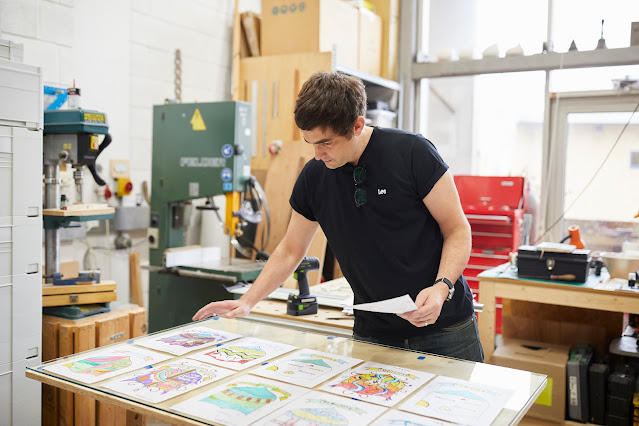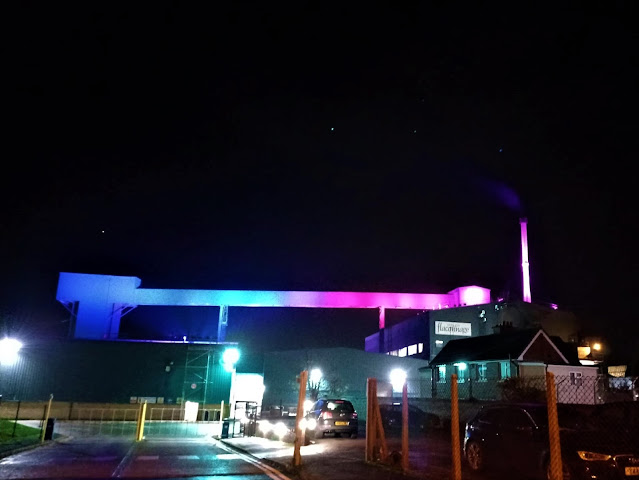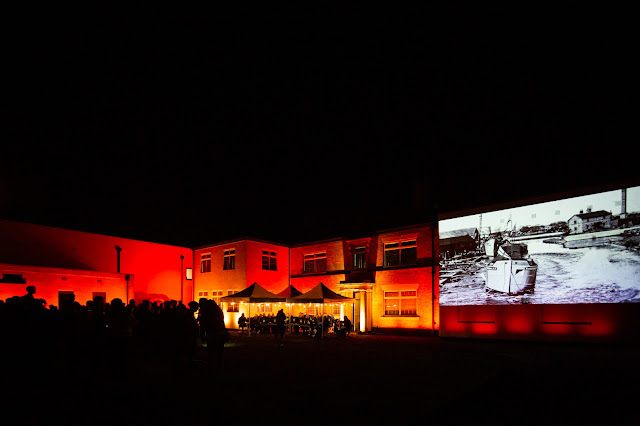Knottingley: Fire & Water was an innovative artwork, with illuminations, projections, and local community responses. It was an evening of wonder, celebration, and community spirit. Over seven months, David immersed himself in the community, working closely with local people to reflect on the Knottingley of the present, as well as the Knottingley of the past. More than 200 people took part.
We've been reflecting on the legacy of the project, and went back to David to capture his thoughts and feelings about Knottingley: Fire & Water, ahead of more digital community resources being released later this year.
Read on to learn about his tips for community engagement and advice to aspiring artists!
 |
| David Appleyard in his studio, reviewing alternative Knottingley town crests created by local schoolchildren. Photo by Nick Singleton. |
Interview with artist David Appleyard
David: The application process followed an open call that was advertised on various national arts websites. As application processes go it was fairly straight-forward. I sent an initial expression of interest and made the shortlisting. I was then given time to develop my approach before being interviewed. The interview itself was friendly and informal and I was given plenty of opportunity to present ideas and working methods.
Advice on applications?
The application process is never as daunting as it might sound, it just takes time. You’ve got to be in it to win it - so just give it a go.
Q: The Knottingley: Fire & Water project was rooted in the local community – how did you get to know the community and build up trust with different individuals and groups?
David: I made a lot of visits to Knottingley and worked with specific groups to make sure that a broad range of people knew about the project.
I was visiting every two to three weeks so I got to know people quite well. The only way to build trust is to maintain communication with them, whether it be in person or online.
Q: What research did you carry out to understand the history and industrial heritage of the town?
David: Initially, I spent time researching Knottingley’s history using various web sources. However, this quickly progressed into the archives at Pontefract Museum where a fantastic collection of archive photographs are held. From the archives I moved out into the community to show people what I had found and to gain feedback.
 |
| One of the archive photographs held by Wakefield Museums and Castles, showing two Bagley & Co workers pouring molten glass from a gathering rod into a mould. Copyright Wakefield Museums and Castles. |
Q: How did your artwork evolve throughout the process? How did your community engagement work shape the final piece?
David: The project developed quite a lot from my initial proposal and was entirely shaped by the stories that were shared, the comments that people added to response cards and the many conversations I had with people living locally.
The most important part of the project was to bring people together in the same way that the glass industry had done years before.
Q: What is the most important element to you: the process, the final outcome, the medium? Or something else?
David: Definitely the process, I never know what I’m going to get as a response and its exciting to work with unknowns. Most of the projects I’ve worked on in the last 15 years have been very different in terms of the outcome and medium. Everything has been driven by research and community involvement.
David: The project developed quite a lot from my initial proposal and was entirely shaped by the stories that were shared, the comments that people added to response cards and the many conversations I had with people living locally.
The most important part of the project was to bring people together in the same way that the glass industry had done years before.
Q: What is the most important element to you: the process, the final outcome, the medium? Or something else?
David: Definitely the process, I never know what I’m going to get as a response and its exciting to work with unknowns. Most of the projects I’ve worked on in the last 15 years have been very different in terms of the outcome and medium. Everything has been driven by research and community involvement.
 |
| David at St Botolph's School in Knottingley, working with local schoolchildren to design their own Knottingley town crests. Photo by Nick Singleton. |
Q: Would you have done anything differently?
David: I’m happy with the way the project evolved. There were a couple of technical hitches on the night but other than that the research and engagement evolved neatly into the final work.
Q: What was the highlight of the project for you, as the artist?
David: There were a number of highlights to the project:
- Witnessing the passion and belief that people can have towards the place where they live.
- Seeing people come out on a cold November night to celebrate their local community.
- The Silver Band performing Ultra Vox's Vienna!
- Having the privilege of working with a really committed team!
 |
| Stoelzle Flaconnage glassworks in Knottingley on the night of the Knottingley: Fire & Water event |
 |
| An Allied Glass building in Knottingley on the night of the Knottingley: Fire & Water event. Copyright Andrew Benge. |

No comments:
Post a Comment
We would love your comments - though they may take a day or two to appear.